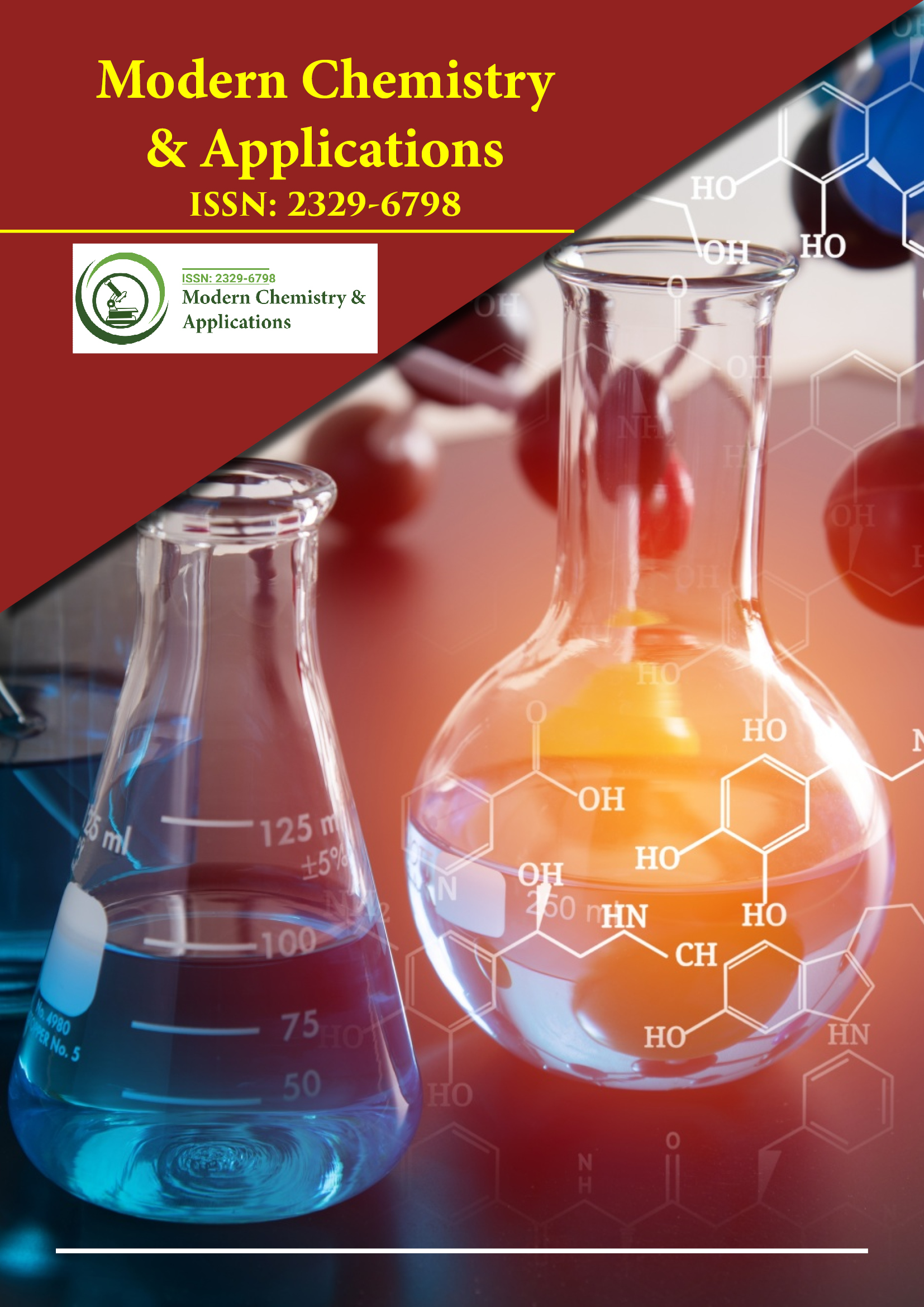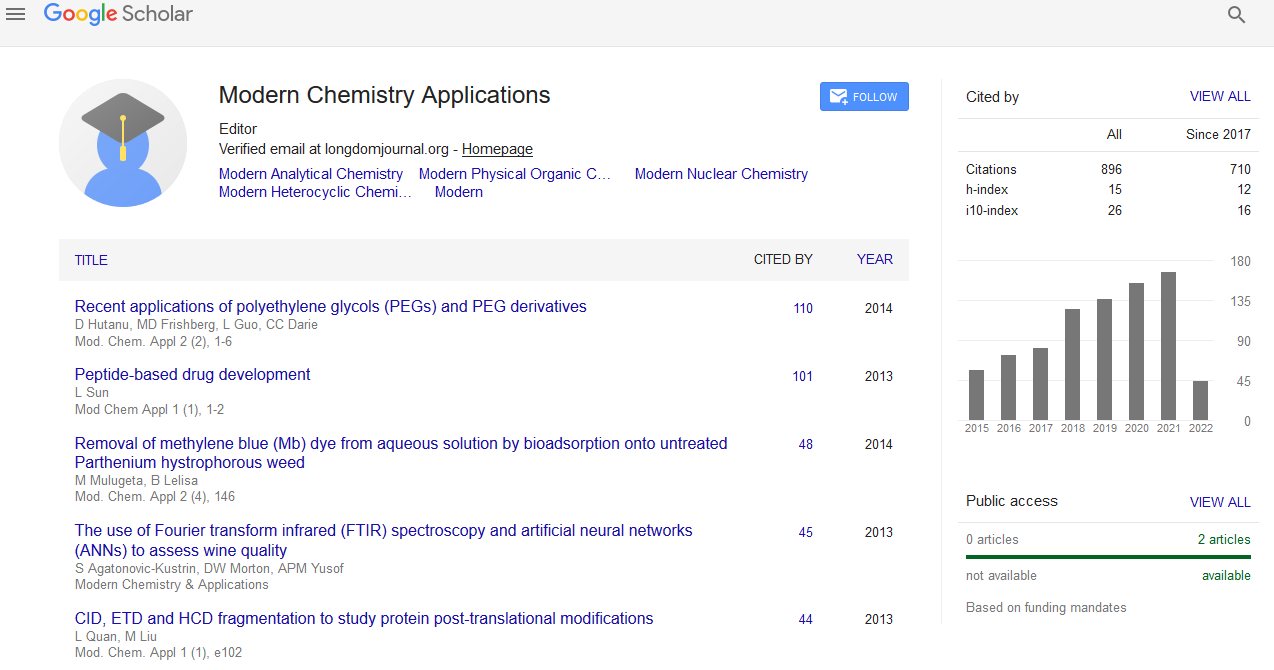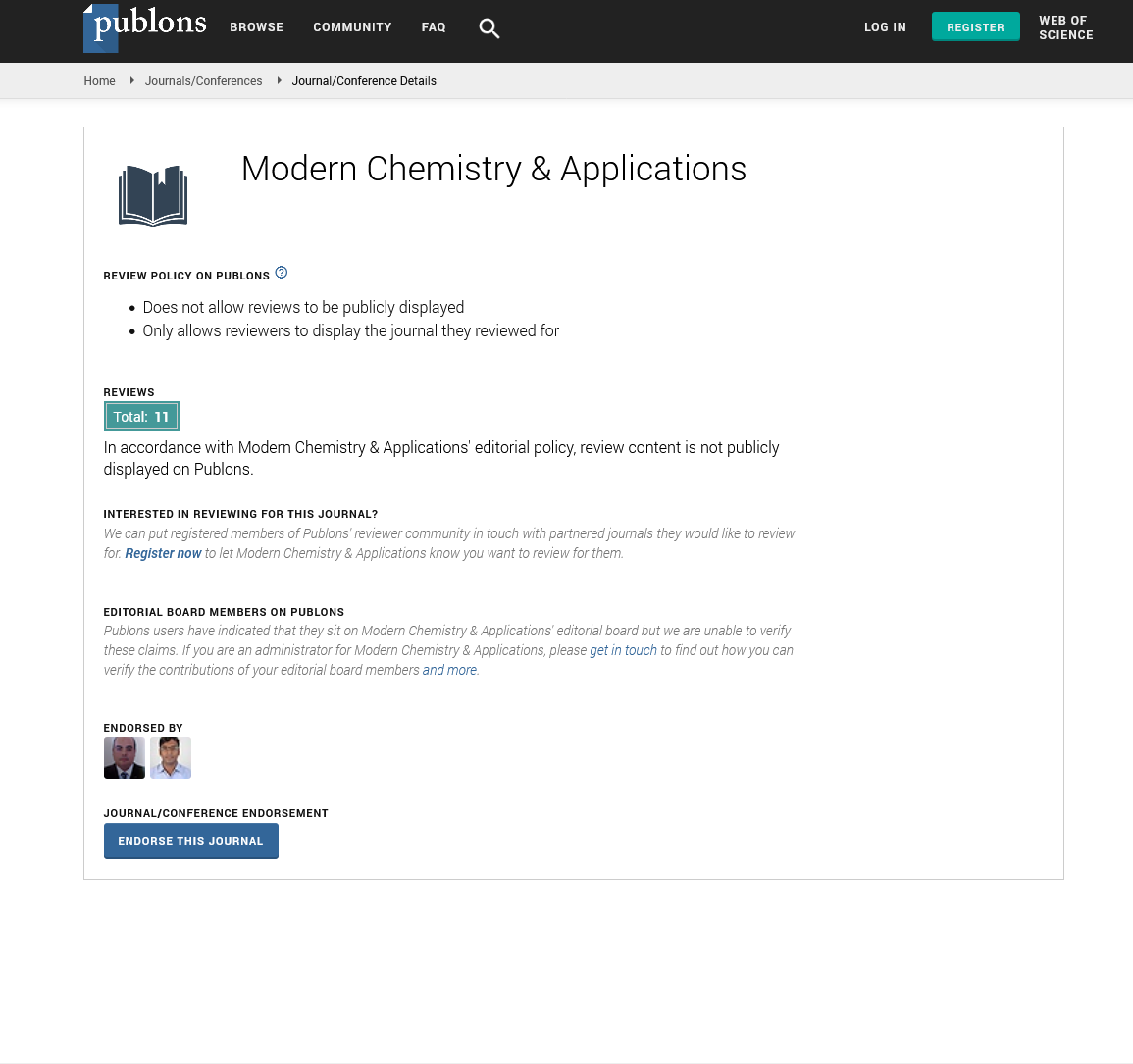Indexed In
- Open J Gate
- JournalTOCs
- RefSeek
- Hamdard University
- EBSCO A-Z
- OCLC- WorldCat
- Scholarsteer
- Publons
- Geneva Foundation for Medical Education and Research
- Google Scholar
Useful Links
Share This Page
Journal Flyer

Open Access Journals
- Agri and Aquaculture
- Biochemistry
- Bioinformatics & Systems Biology
- Business & Management
- Chemistry
- Clinical Sciences
- Engineering
- Food & Nutrition
- General Science
- Genetics & Molecular Biology
- Immunology & Microbiology
- Medical Sciences
- Neuroscience & Psychology
- Nursing & Health Care
- Pharmaceutical Sciences
Perspective - (2025) Volume 13, Issue 2
Hydrophilic Interaction Liquid Chromatography: Approach for Air Quality Assessment
Francesca Pomata*Received: 26-May-2024, Manuscript No. MCA-24-25795; Editor assigned: 29-May-2024, Pre QC No. MCA-24-25795 (PQ); Reviewed: 12-Jun-2024, QC No. MCA-24-25795; Revised: 17-Apr-2025, Manuscript No. MCA-24-25795 (R); Published: 24-Apr-2025, DOI: 10.35248/2329-6798.25.13.494
Introduction
Airborne Particulate Matter (PM) represents a critical environmental and public health issue due to its widespread presence and potential to carry hazardous substances, including organic compounds, heavy metals and biological materials. Effective analysis of PM is essential for monitoring air quality and assessing health risks. Hydrophilic Interaction Liquid Chromatography (HILIC) has emerged as a powerful technique for the analysis of polar compounds in PM, providing enhanced separation capabilities and sensitivity.
Description
Understanding Hydrophilic Interaction Liquid Chromatography (HILIC)
HILIC is a variation of liquid chromatography that is particularly effective for separating and analyzing polar compounds. Unlike traditional Reversed-Phase Liquid Chromatography (RPLC), which uses a non-polar stationary phase, HILIC utilizes a polar stationary phase and a mobile phase that is typically composed of a high percentage of organic solvents mixed with water. The mechanism of HILIC relies on the interaction between the polar analytes and the hydrophilic stationary phase, allowing for the efficient separation of highly polar substances.
Advantages of HILIC in PM Analysis
Enhanced separation of polar compounds: HILIC is exceptionally suited for analyzing highly polar compounds commonly found in PM, such as organic acids, amines and sugars. These compounds are often challenging to separate using traditional RPLC due to their poor retention on non-polar columns.
Improved sensitivity and selectivity: HILIC provides enhanced sensitivity and selectivity for polar analytes, making it possible to detect and quantify trace levels of pollutants in complex PM samples.
Compatibility with mass spectrometry: The mobile phase composition in HILIC, often rich in organic solvents, is highly compatible with Mass Spectrometry (MS), enabling the use of HILIC-MS for detailed molecular characterization and quantification of PM constituents.
Versatility in sample preparation: HILIC can accommodate various sample preparation techniques, including Solid-Phase Extraction (SPE) and Liquid-Liquid Extraction (LLE), facilitating the analysis of a wide range of polar substances in PM samples.
Applications of HILIC in airborne PM analysis
Analysis of organic compounds: Airborne PM contains a diverse array of organic compounds, including Polycyclic Aromatic Hydrocarbons (PAHs), aldehydes and ketones, many of which are polar in nature. HILIC has proven effective in separating and quantifying these substances, providing critical information on the composition and potential toxicity of PM.
Detection of polar metabolites: The metabolism of airborne pollutants by living organisms can lead to the formation of polar metabolites. HILIC is ideal for detecting these metabolites, which can serve as biomarkers for exposure and biological effects. For instance, HILIC-MS can be used to analyze metabolites in biological samples, such as urine or blood, from individuals exposed to polluted air.
Characterization of Water-Soluble Organic Carbon (WSOC): WSOC in PM is an important fraction that can influence cloud formation and climate. HILIC allows for the detailed characterization of WSOC, including the identification of specific organic acids, sugars and other polar compounds, contributing to a better understanding of the sources and environmental impact of PM.
Identification of hydrophilic contaminants: HILIC is highly effective in identifying hydrophilic contaminants in PM, such as inorganic ions and small organic molecules. This capability is essential for comprehensive air quality assessments, enabling the identification of pollutants that may have significant health and environmental effects.
Challenges and future directions
While HILIC offers numerous advantages for PM analysis, there are challenges to address:
Complex matrix effects: PM samples contain a complex mixture of substances that can interfere with the analysis. Developing effective sample preparation and cleanup methods is crucial to mitigate matrix effects.
Column stability and reproducibility: Ensuring the stability and reproducibility of HILIC columns over time can be challenging, requiring careful method validation and routine maintenance.
Integration with other techniques: Combining HILIC with other analytical techniques, such as Gas Chromatography (GC) or Capillary Electrophoresis (CE), can provide complementary information and a more comprehensive analysis of PM.
In the future, advancements in HILIC technology, including the development of new stationary phases and enhanced detection methods, will continue to improve the analysis of airborne PM. Additionally, integrating HILIC with real-time monitoring systems and expanding its application to a broader range of environmental samples will further enhance our understanding of air pollution and its health impacts.
Conclusion
Hydrophilic Interaction Liquid Chromatography (HILIC) stands out as a powerful technique for analyzing airborne particulate matter, particularly for polar compounds that are challenging to separate using traditional methods. Its enhanced sensitivity, selectivity, and compatibility with mass spectrometry make it an invaluable tool in environmental analysis, contributing significantly to air quality monitoring and public health research. As HILIC technology continues to evolve, it will play an increasingly vital role in addressing the complex challenges associated with airborne particulate matter analysis.
Citation: Pomata F (2025) Hydrophilic Interaction Liquid Chromatography: Approach for Air Quality Assessment. Modern Chem Appl. 13:494.
Copyright: © 2025 Pomata F. This is an open-access article distributed under the terms of the Creative Commons Attribution License, which permits unrestricted use, distribution, and reproduction in any medium, provided the original author and source are credited.


